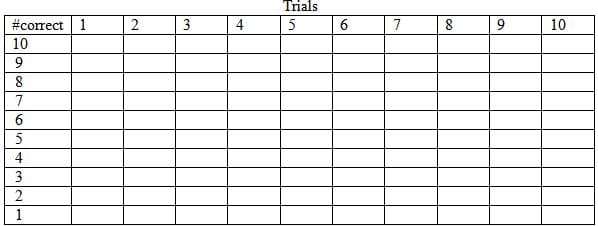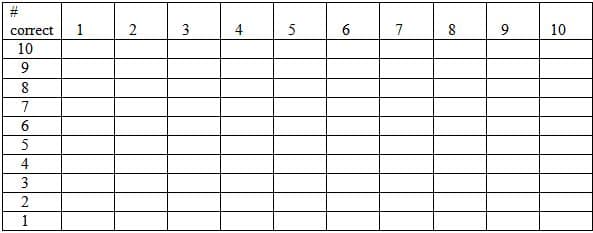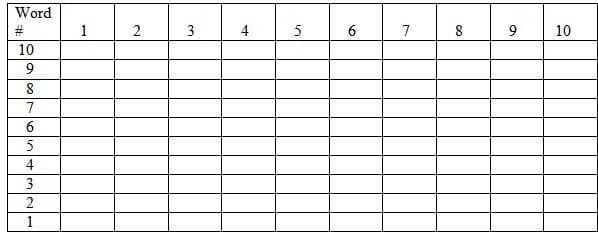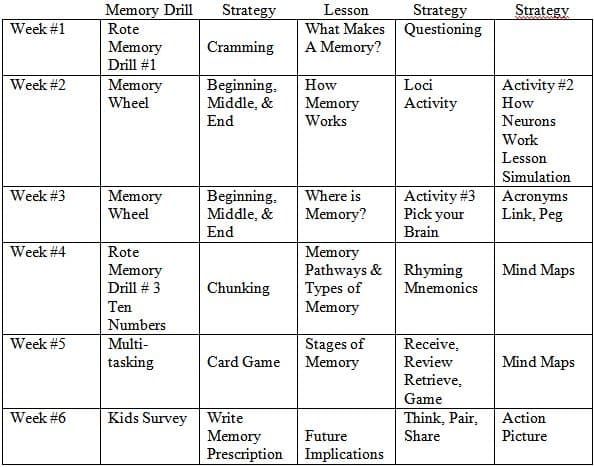Activities
Activity #1
Rote Memory Drills
Word Recall Drill # 1
The teacher will recite to students a list of words. The students will then be asked to write the words on their papers. The teacher will then read the list again. The students will check their papers, indicating how many they remembered. Next, they will record the results on the bar graph in their portfolio. The teacher will continue adding one word to a list of words until there is only one student with a perfect score. That person is the Drill Captain.
First Drill Second Drill Third Drill Fourth Drill
Hunt Play Brain Pickles
Erase Swing Parent Rabbit
Quickly Over Run Hidden
Remove Dog Light Snow
Through Forbidden Lawyer
Shadow Operate
Kitchen
Rote Memory Wheels Drill # 2
Students will draw a circle on tag board using a safety compass and cut it out. Around the circle from outside in, students will equally space and write ten words. Making a smaller circle, the students will place it on top of the larger and cut out a window, to allow for one word at a time to be viewed. The circles will be fastened together with a brad and students are to put their names on the back. Student will pick a classmate's circle, study it for one minute and flop it over. Next students will write as many words as they can remember. Results will be graphed. (Kincher, p.99) By rotating the circles, this exercise may be done for as many days as the number of students in the class. (Day 2- pass circles to person on the right. Day 3 each student gets their circle and the class passes it to the right twice, etc.)
Number Recall Drill # 3
The teacher will recite ten digits. Have students record them. Next, have students check their papers and record the results on the graph. Do this five times and have the students calculate the average number of digits they recalled. Then, the teacher will teach the chunking method, which is to have the numbers grouped. For example 6497453208, would be 649 745 3208. The teacher will do this exercise another five times, and have the students calculate the average number of digits remembered using chunking. Students will be asked to summarize the results in their portfolios.
Activity #2 How Neurons Work
The process of how a neuron works is very complicated for sixth graders to understand, so I have devised a simulation. One student, dressed in a dendrite costume, will send via PVC pipe an electrical charge (plastic egg with wrapped candy inside) to the cell body. The cell body, another student encircled in a hula hoop will transfer the electrical signals, (egg) from one pipe to another. This transfer demonstrates the exchange of positive and negative charges, or action potential. Next, the cell body sends the charge off to the axon through the pipe illustrating the charge being carried to the axon. The axon ends at the synapse. At this point, the candy should shoots out of the pipe, simulating the release of neurotransmitters. If this does not work, another student may be the synapse and release the neurotransmitters. After the first demonstration, students may do it again, but this time sending the charge to another neuron, (dendrite, cell body, and axon). Of course, at the end of the simulation, the students eat the neurotransmitters.
Activity #3 Pick your Brain
To help students remember the parts of the cerebral cortex, a kinesthetic approach will be used in this unit. Referring to the diagram of the cerebral cortex, pairs of students will design the brain parts out of clay. After the parts are fired, they will paint each part an assigned color. Using masking tape and newspaper, students will combine the two hemispheres of the brain, creating a shared brain. At the next class, the students will "pick their brains", quizzing each other on the name and function of the parts of the brain.
Graphs
Use one graph to record data each of the following test. One for the rote memory drill, one for the memory wheel drill, and one for the number drill.
Memory Wheel Drill
Trials

Conclusion:
Numbers Drill
Trials

Conclusion:
Beginning, Middle and End Data
Trials

Lesson Plan Format


Comments: